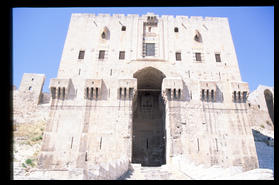 This is the Citadel of Aleppo, one of the dominant features of the Old City. I found that I had a rather difficult time navigating Aleppo, perhaps because it was the first place I had to get around with little use of written signs, which were all in Arabic.
This is the Citadel of Aleppo, one of the dominant features of the Old City. I found that I had a rather difficult time navigating Aleppo, perhaps because it was the first place I had to get around with little use of written signs, which were all in Arabic. It also seemed like the "place to stay" section of Aleppo was pretty far from most of the things that were of interest. And finally, I was there for less than 48 hours, since I heard news that there was a great festival at Palmyra (which turned out to be quite true), and decided to spend more of my time there.
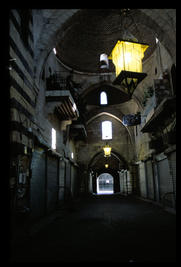 I arrived on Thursday in Aleppo, and when I went out looking around on Friday, many things were closed, such as this, the Souq Bab Antakya. The previous day, I had the opportunity to also visit the meat market, which was staggering reinforcement for my vegetarian eating habits: whole animals hanging on hooks, barrels of every separate animal part for several animal part (i.e., barrel of cow heads, barrel of pig hooves, jar of sheeps' eyes, and the like), all unrefrigerated and covered with flies. It's a wonder the whole populace doesn't keel over from food poisoning; they must have immune systems of steel to be able to deal with it.
I arrived on Thursday in Aleppo, and when I went out looking around on Friday, many things were closed, such as this, the Souq Bab Antakya. The previous day, I had the opportunity to also visit the meat market, which was staggering reinforcement for my vegetarian eating habits: whole animals hanging on hooks, barrels of every separate animal part for several animal part (i.e., barrel of cow heads, barrel of pig hooves, jar of sheeps' eyes, and the like), all unrefrigerated and covered with flies. It's a wonder the whole populace doesn't keel over from food poisoning; they must have immune systems of steel to be able to deal with it. 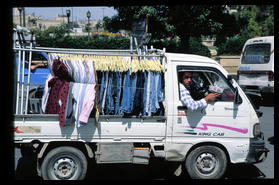 Due to import restrictions, there are very few vehicles of recent manufacture in Syria. In the process of working around these limits, Syrians have created a myriad of fantastic interal combustion vehicles. This is the first of them that I photographed, a man with his clothing business fully integrated with his minivan.
Due to import restrictions, there are very few vehicles of recent manufacture in Syria. In the process of working around these limits, Syrians have created a myriad of fantastic interal combustion vehicles. This is the first of them that I photographed, a man with his clothing business fully integrated with his minivan. 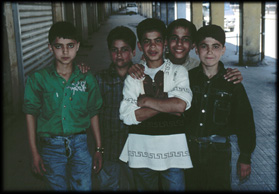 A man walking around with a Nikon SLR is more of a magnet to Middle Eastern children than the ice cream truck. This group of kids were more than happy to pose for several photos.
A man walking around with a Nikon SLR is more of a magnet to Middle Eastern children than the ice cream truck. This group of kids were more than happy to pose for several photos. 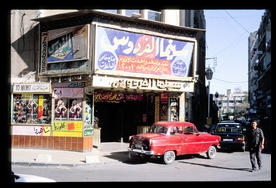 Since I didn't have enough time to actually step in for a movie, one can now only wonder what it is that is shown in these establishments. If the movies that were shown on all of the bus rides -- of Chinese origin, dubbed in English, with Arabic subtitles -- I did well to save my Syrian pounds for other passtimes.
Since I didn't have enough time to actually step in for a movie, one can now only wonder what it is that is shown in these establishments. If the movies that were shown on all of the bus rides -- of Chinese origin, dubbed in English, with Arabic subtitles -- I did well to save my Syrian pounds for other passtimes. 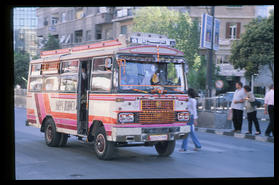 This is what locals call a meecro, older busses that are now being replaced by the ubiquitous Japanese or Korean minibus (KIA is making money hand over fist in the region on those things).
This is what locals call a meecro, older busses that are now being replaced by the ubiquitous Japanese or Korean minibus (KIA is making money hand over fist in the region on those things). I rode on one of these from Damascus to Palmyra in the east of Syria. Since I was one of the last few on the bus, and all the normal seats were taken, I got a broken plastic lawn chair set in the aisle. A kind Syrian guy traded me about halfway there, and made an attempt at discussing regional politics with me (after offering me a cigarette, one of the primary Syrian niceties): "Your President Bush, he... ahhh... Israel Palestine do with make good?" Since there were really about three questions he really could be asking, and three ways he could interpret any possible answer, I made a zipped-mouth gesture. He and his friends laughed and indicated in sign language that I was very wise.
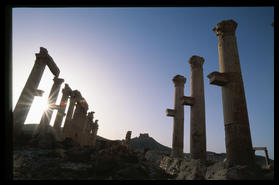 So did I arrive in the desert oasis of Palmyra, an important desert stopover from even before Greek times. It saw its heyday in the 2nd century A.D. under the leadership of Zenobia, a half-Greek, half-Arab queen who attempted to make her city-state separate from Rome. She failed misearably, and ended up kept as a prisoner in Rome, on display to warn of the danger of rebellion, where she supposedly starved herself to death.
So did I arrive in the desert oasis of Palmyra, an important desert stopover from even before Greek times. It saw its heyday in the 2nd century A.D. under the leadership of Zenobia, a half-Greek, half-Arab queen who attempted to make her city-state separate from Rome. She failed misearably, and ended up kept as a prisoner in Rome, on display to warn of the danger of rebellion, where she supposedly starved herself to death. 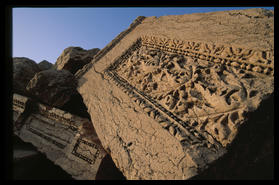 One of many fallen slabs that used to adorn buildings in Palmyra. It's an amazing difference between Syrian ruins and, say, the Parthenon, which I visited several weeks later.
One of many fallen slabs that used to adorn buildings in Palmyra. It's an amazing difference between Syrian ruins and, say, the Parthenon, which I visited several weeks later. Here everything is partly restored (columns restacked, mostly,although several of the main buildings have been more thoroughly reconstructed), but you can walk right up to the stones and touch them; in Greece, there are barriers everywhere, and anything of importance has been taken away to a museum to protect it, leaving the original site diminished.
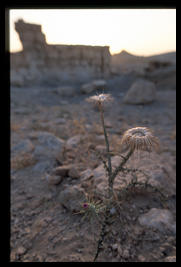 As you head farther to the east, Syria gets drier and drier, and hotter and hotter. Like Luxor later on, it was not possible to do anything in between eleven in the morning and three in the afternoon due to the heat. Compare the spiky, dry foliage here to the lush green of Krek des Chevaliers in the west, a few pictures down from here.
As you head farther to the east, Syria gets drier and drier, and hotter and hotter. Like Luxor later on, it was not possible to do anything in between eleven in the morning and three in the afternoon due to the heat. Compare the spiky, dry foliage here to the lush green of Krek des Chevaliers in the west, a few pictures down from here. 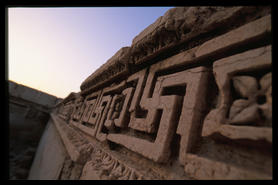 This is a detail from a sunken wall. My guess is that it is a frieze.
This is a detail from a sunken wall. My guess is that it is a frieze. 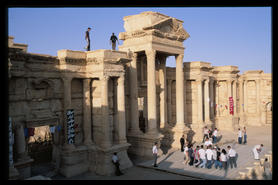 People from all over Syria had flocked to Palmyra for the bedouin festival that was going on. These people are in the Coliseum, one of two heavily-restored buildings. One of them is playing a drum, and the rest were dancing.
People from all over Syria had flocked to Palmyra for the bedouin festival that was going on. These people are in the Coliseum, one of two heavily-restored buildings. One of them is playing a drum, and the rest were dancing. Later on that night, there was an enormous concert in the Temple of Bel, the other restored building, which is much larger. I didn't think much of the music, but people kept approaching me and attempting to try out their limited English, which they often used to express surprise that I was in Syria at all -- which was one of the things I liked most about the country, that they were so few tourists that the locals considered us an oddity. You won't get that in Cairo or Amman.
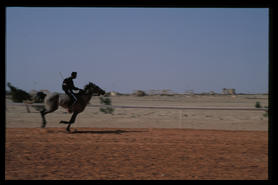 There were also horse and camel races at the festival; this rider is taking warm-up laps several hours before the races. Later on, we were treated quite nicely and given places near the track on mats to sit down.
There were also horse and camel races at the festival; this rider is taking warm-up laps several hours before the races. Later on, we were treated quite nicely and given places near the track on mats to sit down. Another traveller I talked to later on in Petra reported being at one of the more popular camel races later on the same day, and that the tourist police were all but beating people out of the way in order to make way for them to have front row seats, despite protests from pretty much everyone involved.
 This is the Qal`at Ibn Ma`an, usually translated as "Arab Castle" ("Qal`at" is castle, I'm not sure what "Ibn Ma`an" is), with two crumbling funerary towers in the foreground.
This is the Qal`at Ibn Ma`an, usually translated as "Arab Castle" ("Qal`at" is castle, I'm not sure what "Ibn Ma`an" is), with two crumbling funerary towers in the foreground. There are other towers that have stood the test of time better, and for which tours can be arranged. Despite the way it looks, the hike up to the castle, although somewhat treacherous, only takes about half an hour. The castle itself was built in the 12th or 13th century by a Fakhr-al-Din to serve as protection from crusaders.
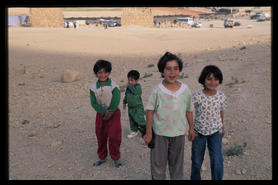 More children magnetically attracted to the presence of cameras. Due to the greater tourist presence in Palmyra (and the fact that they were gypsy children), these ones were actually cunning enough to ask for money in return for their photograph.
More children magnetically attracted to the presence of cameras. Due to the greater tourist presence in Palmyra (and the fact that they were gypsy children), these ones were actually cunning enough to ask for money in return for their photograph. 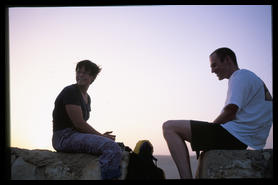 These were two French that I met in Palmyra, and hiked up to Qal`at Ibn Ma`an with. I've forgotten their names, but the guy had good taste in music.
These were two French that I met in Palmyra, and hiked up to Qal`at Ibn Ma`an with. I've forgotten their names, but the guy had good taste in music.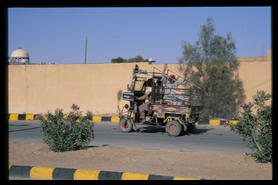 Since there is nowhere to really drive to in Palmyra -- the town is probably three miles across -- many people get around on these three-wheeled vehicles.
Since there is nowhere to really drive to in Palmyra -- the town is probably three miles across -- many people get around on these three-wheeled vehicles. 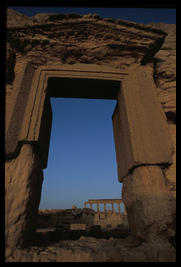 A doorway in the "Diocletian's Camp" section of Palmyra, at sunset.
A doorway in the "Diocletian's Camp" section of Palmyra, at sunset. 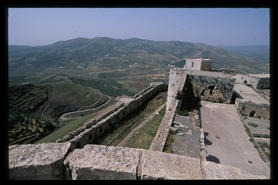 After another meecro ride back to Homs, the central transport hub of Syria (which, incidentally, is pronouced "Hom'sss"; I kept trying to tell people I wanted to go to "Homs" and they kept looking at me like I was nuts), I arrived at Krek des Chevaliers, the greatest Crusader castle ever built. Known also as "Qal`at Hosn" ("The Castle at Hosn", the surrounding village), it dominates the landscape for miles around.
After another meecro ride back to Homs, the central transport hub of Syria (which, incidentally, is pronouced "Hom'sss"; I kept trying to tell people I wanted to go to "Homs" and they kept looking at me like I was nuts), I arrived at Krek des Chevaliers, the greatest Crusader castle ever built. Known also as "Qal`at Hosn" ("The Castle at Hosn", the surrounding village), it dominates the landscape for miles around. 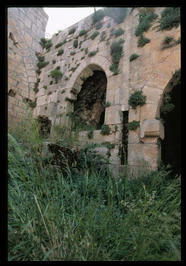 A grassy area looking into what was the Guard's Quarters.
A grassy area looking into what was the Guard's Quarters. 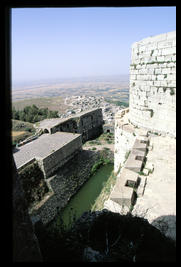 Standing on the top of Krek, I could only imagine the feeling of power that must have imbued a knight of the middle ages in the same location. Krek is like the 12th century equivalent of a nuclear aircraft carrier.
Standing on the top of Krek, I could only imagine the feeling of power that must have imbued a knight of the middle ages in the same location. Krek is like the 12th century equivalent of a nuclear aircraft carrier. It was built to hold a garrison of 2000, which was eventually depleted to 200. Although they had stores for five years (lots of beef jerky, presumably), they eventually gave up in return for safe passage home.
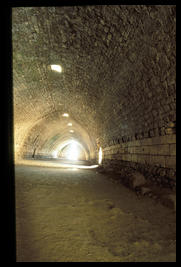 This is the hall that runs around the exterior wall of the castle.
This is the hall that runs around the exterior wall of the castle. 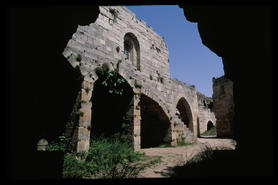 This is from inside of the loggia (an open roofed gallery) towards the chapel, and the stairwells leading up to the upper area and towers.
This is from inside of the loggia (an open roofed gallery) towards the chapel, and the stairwells leading up to the upper area and towers. 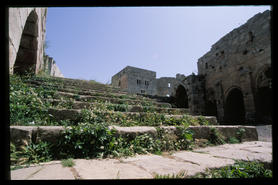 And this is the reverse angle, looking into the loggia and up the stairwell.
And this is the reverse angle, looking into the loggia and up the stairwell. 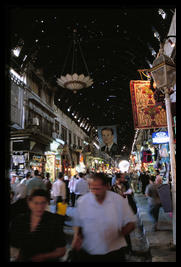 I had to pay a driver a whopping $7 to give me a ride back to Homs from Krek, since I was the only tourist leaving there at three in the afternoon in May -- one of many indications of depressed tourism in the area due to the conflict in Israel.
I had to pay a driver a whopping $7 to give me a ride back to Homs from Krek, since I was the only tourist leaving there at three in the afternoon in May -- one of many indications of depressed tourism in the area due to the conflict in Israel. After one more bus ride, I arrived in Damascus, capital of Syria and the worlds oldest continuously inhabited city. Pictured here is the Souq al-Hamidiyya (a "souq" is a marketplace), remarkable for it's very high curved tin roof.
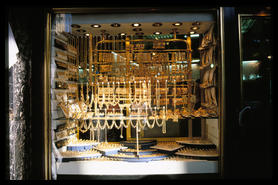 A gold store in the Souq.
A gold store in the Souq. 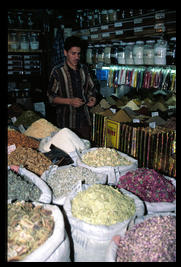 A spice merchant in the souq, with enormous bags of every kind of middle eastern spice you can imagine.
A spice merchant in the souq, with enormous bags of every kind of middle eastern spice you can imagine. 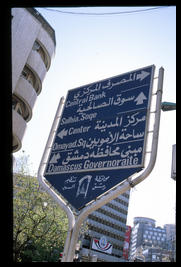 I found Damascus to be easier to navigate than Aleppo, and the rare English sign such as this one made it even better. All the same, it's hard to get around when you have to hunt so hard for clues about the name of the street or square you're located in.
I found Damascus to be easier to navigate than Aleppo, and the rare English sign such as this one made it even better. All the same, it's hard to get around when you have to hunt so hard for clues about the name of the street or square you're located in. 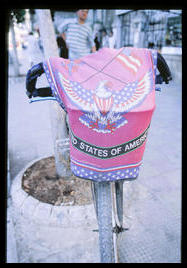 There was very little anti-U.S.A. sentiment in Syria; on the contrary, there seemed to be something of a fascination with the United States, as this bicycle shows.
There was very little anti-U.S.A. sentiment in Syria; on the contrary, there seemed to be something of a fascination with the United States, as this bicycle shows. People would come up to me on the street, or in museums, just to ask me where I was from, and they usually seemed delighted and fascinated that I was something so rare as an American. It was less so in Jordan, where the large Palestinian population -- refugees from lack of economic opportunity in the Palestinian territories -- have less warm feelings about us.
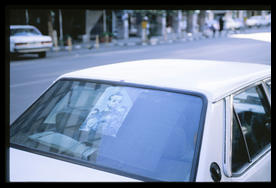 Images of Assad are everywhere. Check out the first photo of Damascus, above, where he hangs above it all. People put him in their cars, as here, to imply that they are "in" with the government.
Images of Assad are everywhere. Check out the first photo of Damascus, above, where he hangs above it all. People put him in their cars, as here, to imply that they are "in" with the government. Pictured here is the elder Assad, Hafez, who passed away in June of 2000. Originally his eldest son, Bassel, was unofficially the heir-apparent for the Syrian Presidency until his untimely death in a car accident. Bashar Assad, trained as a ophthalmologist in England, was recalled to Syria and has succeeded his father, introducing some reforms such as Internet access, but has largely maintainted similar policies to his father.
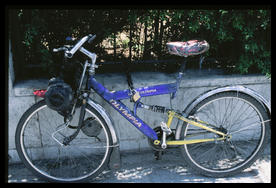 Another internal-combustion oddity, the motorized mountain bike.
Another internal-combustion oddity, the motorized mountain bike. 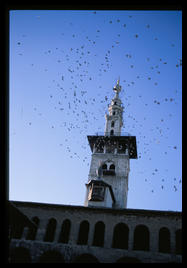 This is the Umayyad Mosque in Damascus was built in 705 on the site of a Christian cathedral (which was built on the site of temples to Greek and Aramaean gods), it was severely damaged and then restored after a fire in 1893.
This is the Umayyad Mosque in Damascus was built in 705 on the site of a Christian cathedral (which was built on the site of temples to Greek and Aramaean gods), it was severely damaged and then restored after a fire in 1893. Having mostly been in Catholic churches, I was surprised at how much the mosque was a center for social life, with people chatting, children running around, and the like. Visitors were welcome to walk around both the courtyard as well as the interior of the Mosque, where the head of St. John the Baptist is enshrined.
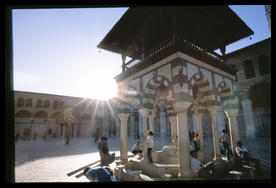 This is the fountain for washing before prayer, but many of the people around it were simply hanging out and chatting when I was there.
This is the fountain for washing before prayer, but many of the people around it were simply hanging out and chatting when I was there. 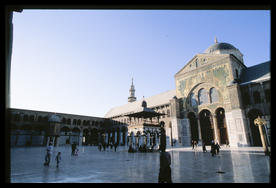 The gold-laced facade of the Umayyad mosque.
The gold-laced facade of the Umayyad mosque. 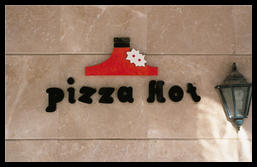 Syria is not known for its copyright and trademark laws; "Pizza Hot" had plenty of company in heisted logos. Several computer companies had taken to using the Internet Exporer logo as their own, and when the first (real, licensed) Kentucky Fried Chicken opened in Damascus, the government later decided that it was too western. The owner closed for a short period of time, and then re-opened as the "Kuwaiti Food Company", using the same KFC logo.
Syria is not known for its copyright and trademark laws; "Pizza Hot" had plenty of company in heisted logos. Several computer companies had taken to using the Internet Exporer logo as their own, and when the first (real, licensed) Kentucky Fried Chicken opened in Damascus, the government later decided that it was too western. The owner closed for a short period of time, and then re-opened as the "Kuwaiti Food Company", using the same KFC logo. 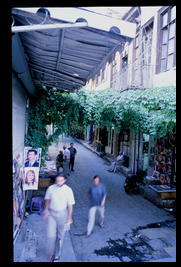 This is the street to the Al-Haramain hotel. Like many of the pedestrian streests of Damascus, it has wire run above it, with vines growing down from them. The result is very green, shaded, and pleasant.
This is the street to the Al-Haramain hotel. Like many of the pedestrian streests of Damascus, it has wire run above it, with vines growing down from them. The result is very green, shaded, and pleasant. 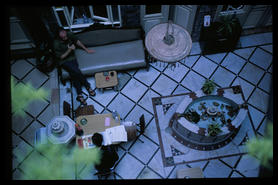 This is taken from the second floor of the hotel I was staying at, the Al Haramain. The hotel dates (by their own claim) from 1200 A.D., with a very impressive in-floor goldfish tank you can see here.
This is taken from the second floor of the hotel I was staying at, the Al Haramain. The hotel dates (by their own claim) from 1200 A.D., with a very impressive in-floor goldfish tank you can see here. The ceiling above me is open; I guess there is so little rain that it doesn't really matter that it rains in the central room when it does. The rooms are cheap, and the clientele have been everywhere, I highly recommend it.
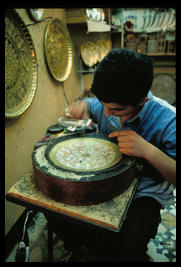 Inlaid metal plates and wooden boxes are the stock souvenirs for Damascus. Here, a boy hammers away for a living in a storefront, doubling as an advertisement for the wares.
Inlaid metal plates and wooden boxes are the stock souvenirs for Damascus. Here, a boy hammers away for a living in a storefront, doubling as an advertisement for the wares. 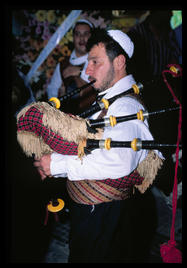 Although this fellow looks like he should be eating haggis instead of hummous, bagpipes were actually invented in Syria in about 100 A.D.
Although this fellow looks like he should be eating haggis instead of hummous, bagpipes were actually invented in Syria in about 100 A.D. I didn't know that at the time, but I was still happy to stumble on this spontaneous display of music and dancing in the streets of Damascus.
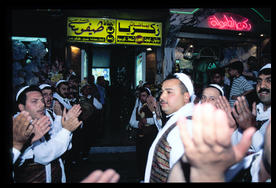
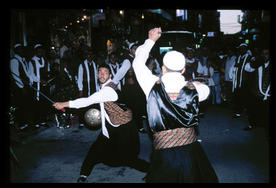 The same dancers put on what I assume was a traditional Syrian display of swordfighting, which was impressively energetic and realistic.
The same dancers put on what I assume was a traditional Syrian display of swordfighting, which was impressively energetic and realistic. 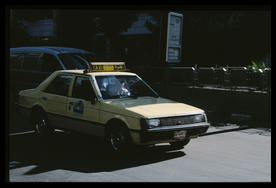 This is the standard Syrian taxi; they are mostly of Russian and Eastern European manufacture from the 1980's at the earliest. Most of them have the seatbelts ripped out, despite the fact that most traffic rules are optional, brakes are considered a last resort after you've tried honking, and headlights are left off at night except as a signal to other drivers or pedestrians that they're in your way.
This is the standard Syrian taxi; they are mostly of Russian and Eastern European manufacture from the 1980's at the earliest. Most of them have the seatbelts ripped out, despite the fact that most traffic rules are optional, brakes are considered a last resort after you've tried honking, and headlights are left off at night except as a signal to other drivers or pedestrians that they're in your way. 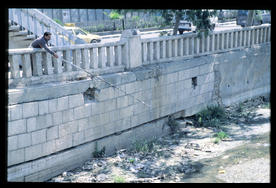 You should have seen the trout I caught yesterday! It was thiiiiis big!
You should have seen the trout I caught yesterday! It was thiiiiis big! 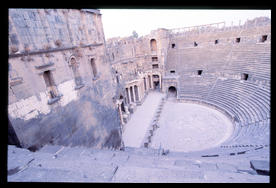 This is the amphitheatre at Bosra, around which a fortress was built subsequently. The interesting thing about it, and the reason that I made it a stop that might otherwise have been skipped, is that you can stay there overnight, and you're free to wander about the castle at night among the statues and the bats. Well worth your time.
This is the amphitheatre at Bosra, around which a fortress was built subsequently. The interesting thing about it, and the reason that I made it a stop that might otherwise have been skipped, is that you can stay there overnight, and you're free to wander about the castle at night among the statues and the bats. Well worth your time.
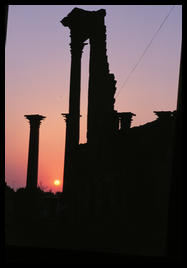 Sunset among the ruins at Bosra.
Sunset among the ruins at Bosra.
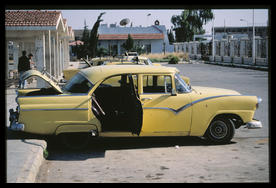 The crossing from Bosra to Jordan requires a vehicle, so I joined up with the Australians from the Bosra amphitheathre to rent this taxi.
The crossing from Bosra to Jordan requires a vehicle, so I joined up with the Australians from the Bosra amphitheathre to rent this taxi. The Jodanian border authorities had them take out the seats, and they searched the engine compartment, everything. By contrast, they had us open our bags, took a quick peek without even really moving anything around, and that was that.
